| Weight | 1 lbs |
|---|---|
| Dimensions | 9 × 5 × 2 in |
| host | mouse |
| isotype | IgG1 |
| clonality | monoclonal |
| concentration | concentrate, predilute |
| applications | IHC |
| reactivity | human |
| available size | 0.1 mL, 0.5 mL, 1 mL concentrated, 7 mL prediluted |
mouse anti-CD3 monoclonal antibody (ZM45) 6421
Price range: $160.00 through $528.00
Antibody summary
- Mouse monoclonal to CD3
- Suitable for: Immunohistochemistry (formalin-fixed, paraffin-embedded tissues)
- Reacts with: Human
- Isotype:IgG1
- Control: Tonsil
- Visualization: Membrane
- 0.1, 0.5, 1.0 mL concentrated, 7 mL prediluted
mouse anti-CD3 monoclonal antibody ZM45 6421
| target relevance |
|---|
| Protein names T-cell surface glycoprotein CD3 epsilon chain (T-cell surface antigen T3/Leu-4 epsilon chain) (CD antigen CD3e) |
| Gene names CD3E,CD3E T3E |
| Mass 23147Da |
| Function FUNCTION: Part of the TCR-CD3 complex present on T-lymphocyte cell surface that plays an essential role in adaptive immune response. When antigen presenting cells (APCs) activate T-cell receptor (TCR), TCR-mediated signals are transmitted across the cell membrane by the CD3 chains CD3D, CD3E, CD3G and CD3Z. All CD3 chains contain immunoreceptor tyrosine-based activation motifs (ITAMs) in their cytoplasmic domain. Upon TCR engagement, these motifs become phosphorylated by Src family protein tyrosine kinases LCK and FYN, resulting in the activation of downstream signaling pathways (PubMed:2470098). In addition of this role of signal transduction in T-cell activation, CD3E plays an essential role in correct T-cell development. Initiates the TCR-CD3 complex assembly by forming the two heterodimers CD3D/CD3E and CD3G/CD3E. Also participates in internalization and cell surface down-regulation of TCR-CD3 complexes via endocytosis sequences present in CD3E cytosolic region (PubMed:10384095, PubMed:26507128). In addition to its role as a TCR coreceptor, it serves as a receptor for ITPRIPL1. Ligand recognition inhibits T-cell activation by promoting interaction with NCK1, which prevents CD3E-ZAP70 interaction and blocks the ERK-NFkB signaling cascade and calcium influx (PubMed:38614099). {ECO:0000269|PubMed:10384095, ECO:0000269|PubMed:12110186, ECO:0000269|PubMed:15294938, ECO:0000269|PubMed:15546002, ECO:0000269|PubMed:2470098, ECO:0000269|PubMed:26507128, ECO:0000269|PubMed:38614099, ECO:0000269|PubMed:8490660}. |
| Subellular location SUBCELLULAR LOCATION: Cell membrane {ECO:0000269|PubMed:10384095, ECO:0000269|PubMed:15294938}; Single-pass type I membrane protein {ECO:0000305}. |
| Structure SUBUNIT: The TCR-CD3 complex is composed of a CD3D/CD3E and a CD3G/CD3E heterodimers that preferentially associate with TCRalpha and TCRbeta, respectively, to form TCRalpha/CD3E/CD3G and TCRbeta/CD3G/CD3E trimers. In turn, the hexamer interacts with CD3Z homodimer to form the TCR-CD3 complex. Alternatively, TCRalpha and TCRbeta can be replaced by TCRgamma and TCRdelta. Interacts with CD6 (PubMed:15294938). Interacts (via Proline-rich sequence) with NCK1; the interaction is ligand dependent but independent of tyrosine kinase activation (PubMed:12110186, PubMed:15972658, PubMed:38614099). Interacts with NUMB; this interaction is important for TCR-CD3 internalization and subsequent degradation (PubMed:26507128). {ECO:0000269|PubMed:12110186, ECO:0000269|PubMed:15136729, ECO:0000269|PubMed:15294938, ECO:0000269|PubMed:15534202, ECO:0000269|PubMed:15972658, ECO:0000269|PubMed:26507128, ECO:0000269|PubMed:38614099, ECO:0000269|PubMed:9698567}. |
| Post-translational modification PTM: Phosphorylated on Tyr residues after T-cell receptor triggering by LCK in association with CD4/CD8. {ECO:0000269|PubMed:2470098}. |
| Involvement in disease DISEASE: Immunodeficiency 18 (IMD18) [MIM:615615]: An autosomal recessive primary immunodeficiency characterized by onset in infancy or early childhood of recurrent infections. The severity is variable, encompassing both a mild immunodeficiency and severe combined immunodeficiency (SCID), resulting in early death without bone marrow transplantation in some patients. Immunologic work-up of the IMD18 SCID patients shows a T cell-negative, B cell-positive, natural killer (NK) cell-positive phenotype, whereas T-cell development is not impaired in the mild form of IMD18. {ECO:0000269|PubMed:15546002, ECO:0000269|PubMed:8490660}. Note=The disease is caused by variants affecting the gene represented in this entry. |
| Target Relevance information above includes information from UniProt accession: P07766 |
| The UniProt Consortium |
Data
 |
| Human lymph node stained with anti-CD3 antibody using peroxidase-conjugate and DAB chromogen. Note the membranous staining of perifollicular T-cells and no stain in B-cells. |
Publications
| pmid | title | authors | citation |
|---|---|---|---|
| We haven't added any publications to our database yet. | |||
Protocols
| relevant to this product |
|---|
| IHC |
Documents
| # | SDS | Certificate | |
|---|---|---|---|
| Please enter your product and batch number here to retrieve product datasheet, SDS, and QC information. | |||
Only logged in customers who have purchased this product may leave a review.

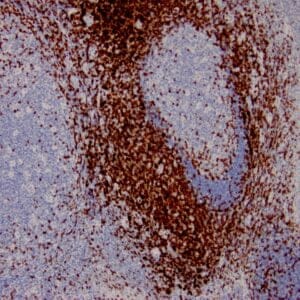

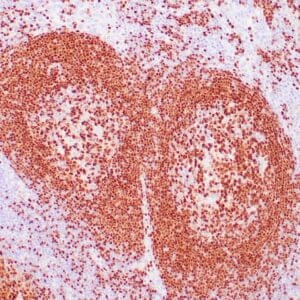
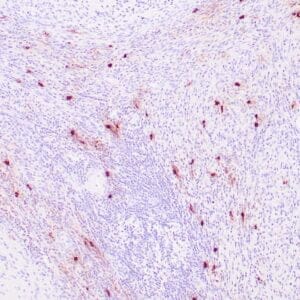
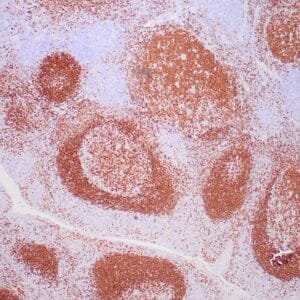


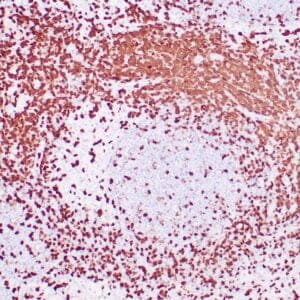

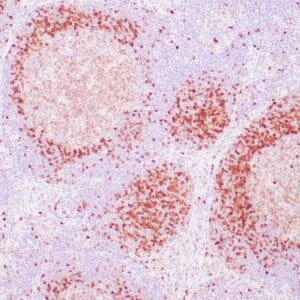

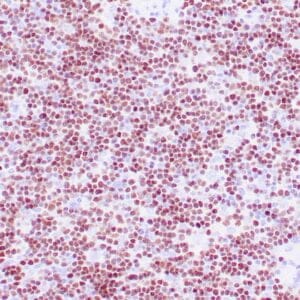
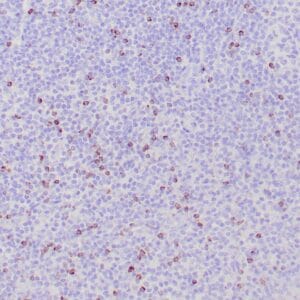
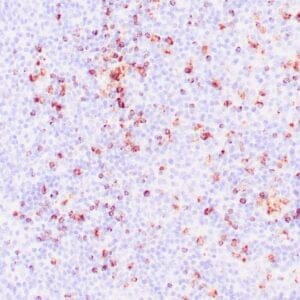
Reviews
There are no reviews yet.